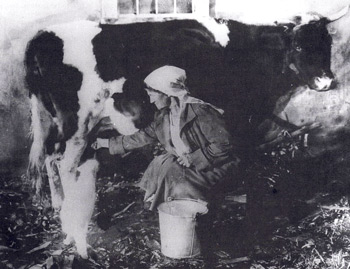B A C K T H E N
Milking Cows

Photo courtesy of Chansoneta Emmons; Cutler Memorial Library, Farmington, from the Historic Maine Photo Collection, Department of Special Collections, Raymond H. Fogler Library, University of Maine
Milking a Durham cow, feeding a cat, Kingfield, 1905. Kerchief and frock protect the milker from the dirt and hairs of the cow, and the milk from dust and hair from the milker. Only goggles or a patent tail hobble would protect the milker from the eye-smarting tail switch, a prime depositor of undesirable foreign substances in milk. Cows were milked from the right-hand side, probably so that a right handed milker might snatch the bucket away from a proffered manure-laden hoof. Usually this occurred just as the final squirts of highest-fat milk were being “stripped” out.
In 1908, 250,000 dairy cows and heifers were kept on 60,000-odd Maine farms, and milking ranked among the state’s most common daily activities. Nevertheless, photos of cows being milked are rare. Cows were often milked outdoors, as here, since most cows were bred to calve, or “freshen,” in the spring, when good grazing was available. Milk milked outside was sweeter than milk from the stale tie-up. Females (and children) were the traditional milkers. In 1904 G.M. Gowell, a professor at Orono, recalled:
I remember, in the home of my boyhood, in one of the most prosperous agricultural sections of the State, it was the common custom all up and down the road for the girls to do the milking, out in the open pastures, morning and evening, while the men and boys were busy with farm work. As proof that this was not regarded as an irksome task, I recall that the summer school teacher with her pink dress and white frock, with skirts tucked up and sleeves rolled back, sometimes took a pail and helped the rest of the girls that they might get done the earlier and afterwards all go on a romp together. Ah, the milk! Why shouldn’t it be sweet and clean? Clean cows that had the green sward for their beds and the starry skies for their shelter.
Milking cows through the winter, in barns and by men, did not become commonplace until the advent of “associated” dairy farming and year-round markets. Not only did it take men time to get used to milking cow, but it took cows time to get used to being milked by men. Stale milk then became a problem. While milk from a healthy udder is essentially sterile, the process of milking even a clean cow in a clean barn by a clean milker creates a rain of bacteria into the open bucket. Nor was good hygiene aided by the nervous cow who dipped her toe in the bucket, no matter how quickly the larger pieces of flotsam were fished out afterwards. Seams in buckets and cans were major bacteria reservoirs.
Milk was fed to infants, calves, hens, and hogs. Children did not like milk, and drank as little as possible, while adults drank practically none, aside from bracing dippers of buttermilk. Cream and milk peddled by local village dairyman were sold practically right out of the cow, and had little chance to spoil, but when creameries began shipping to distant markets, the poor keeping qualities of dirty milk and cream became a problem. When milk began to be sold in bottles, rather than by the dipper, consumers learned to look not only for cream risen in the neck, but also for the hairs and dirt settled on the bottom.
Measures to improve the milk supply came first from city governments (particularly Portland’s). Aside from problems at the farm, the common practice of milk handlers testing for sweetness by “applying the tongue to the milk end of the can stopper” was cited as a source of disease. Along with with causing epidemics of typhoid, diphtheria, and scarlet fever (not to mention tuberculosis), “dirty” milk was held to be the chief cause of infantile diarrhea — “summertime cholera” — responsible for half of the deaths of infants under one year of age. Ultimately, pasteurized milk (as distinct from poor-tasting “sterilized,” or cooked, milk) which was quickly heated to just below boiling, and then quickly cooked, would be the key to the rise of milk as a beverage, and the great expansion of dairy farming.
In the days of hand-milking, few cows received unconditional affection from their milkers, or vice versa. “Hard-milking” cows had meaty, unhandy teats, or else small teats not large enough to hand. Maternal cows refused to “let down” their milk for anyone other than their calf. Spiteful, “spleeny” cows let fly well-aimed kicks — the cow is possibly the only creature that can kick sideways, and with any foot. And then there was the rare biter. Before antibiotics, mastitis — “garget” — was a vexing problem, and likely “blind” udder quarters were common. Life being what it is, the ideal “easy milker,” who stood like a statue while her milk all but flowed into the brimming pail, her udder “milking out like the proverbial wet washrag, would be the one likely to cut off the end of a teat with a hoof, cast her withers calving, not “settle” with the bull, test positive for TB, die a horrible death from “hardware disease” (usually caused by an ingested roofing nail or piece of old fence wire), or, if all else failed, choke to death on a potato.
Text by William H. Bunting from A Day’s Work, A Sampler of Historic Maine Photographs, 1860-1920, Part I. Published by Tilbury House Publishers, Gardiner, Maine, 800-582-1899
